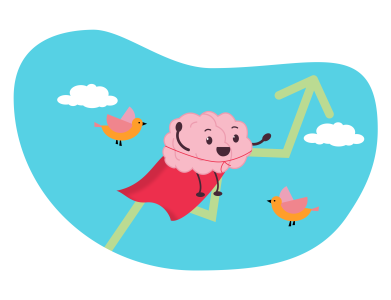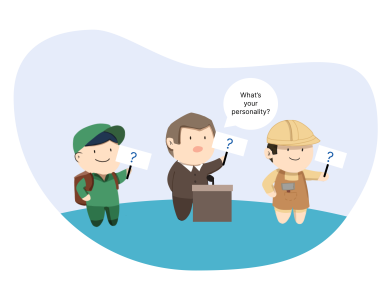
- GRIP Learning's Team
Today you’ll learn about neuroplasticity and the ways to increase it! Here are some guides on how to increase neuroplasticity through ...
Do you ever ponder what an INTJ or an ESTP actually means when someone uses those letters to describe themselves? Personality types according to the Myers-Briggs system are what these people are discussing (MBTI).
The Myers-Briggs Type Indicator is a self-report inventory used to gain insight into a person’s mentality, strengths, and preferences. Isabel Myers and her mother, Katherine Briggs, made the questionnaire based on what they learned about Carl Jung’s theory of personality types. The Myers-Briggs Type Indicator (MBTI) inventory is currently one of the most popular personality tests available.
This article talks about the history of the Myers-Briggs Type Indicator (MBTI). It also talks about the 16 different MBTI personality types and how each of them works.
Jung’s theory of psychological types interested both Myers and Briggs, and they could see how it could be used in real life. During World War II, they started to make an indicator that could be used to better understand how different people are.
Myers and Briggs believed that if they could help people better understand themselves, they could guide them toward careers that were a good fit for their unique personalities.
In the 1940s, Myers developed the first pen-and-pencil version of the inventory, and the two women started field-testing it on friends and family. Over the next 20 years, they finished making the instrument.
A person’s personality is classified into one of 16 categories based on how they respond to the inventory’s questions. The purpose of the MBTI is to provide insight into one’s personality, interpersonal style, and preferred activities at work and in leisure.
There is no such thing as a “best” personality type. In reality, all it aims to do is aid you in becoming more self-aware. There are a total of four scales within the questionnaire.
Jung’s theory of personality types was one of the first to look at the difference between extraversion and introversion as a way to describe how people react to and interact with the outside world. While most people will be familiar with these terms, the MBTI uses them slightly differently than modern usage.
“Extroverted” (also spelled “extroverted”) people are more likely to take the lead, have a greater need for social interactions, and get more energy from them. The characteristics that make an individual an introvert are an emphasis on introspection, a preference for more profound forms of human connection, and a need for quiet time alone to recharge.
Even though we’re all capable of both extroversion and introversion, most people lean more toward one or the other.
The method by which individuals take in information from their surroundings is the focus of this measure. Everyone, whether more extroverted or introverted, spends time sensing and intuiting. According to the MBTI, everyone has a strong inclination toward one of the 16 possible types.
Sensing people tend to be very in touch with reality and the information they can get from their senses. They pay close attention to detail and benefit greatly from direct experience. Those who rely more on their gut instincts pay closer attention to things like patterns and first impressions. They take pleasure in speculating on potential outcomes, visualizing alternative worlds, and contemplating theoretical abstractions.
This scale looks at how people make decisions, and it shows that the sensing and intuition functions are very important. Those who would rather think than feel place a value on hard evidence and empirical research.
When weighing a decision, they are typically consistent, logical, and detached. Those who think and act more intuitively are more likely to factor the feelings of others into their decisions.
The final scale evaluates how a person typically deals with the outside world. Those who are more likely to judge value order and decisive action. Those who are more perceptive by nature tend to be receptive, adaptable, and flexible. These two tendencies have a dynamic relationship with the other scales.
Keep in mind that everyone spends some time participating in extroverted pursuits. Whether you are an introvert or extrovert in your approach to learning new things (sensing and intuition) and making choices (judging), the judging-perceiving scale can help (thinking and feeling).
The Myers-Briggs Foundation has found that the Myers-Briggs Type Indicator (MBTI) is accurate and reliable. On the official website for the test, it says that both the reliability from test to test and the accuracy are 90%. While there were some differences between studies, the findings were consistent overall, suggesting that the scale has high internal consistency and test-retest reliability.
According to new studies, more work is needed to prove the instrument’s validity and reliability. Some studies have shown, for instance, that test scores can vary widely from take to take and that they are not a reliable indicator of future success in various fields of endeavor.

Each type has a four-letter code:
ISTJ: The Inspector: usually quiet and down-to-earth, as well as reliable, traditional, and organized.
ISTP – The Crafter: likes to learn by doing and does best when they are free to follow their own interests.
ISFJ – The Protector: fiercely loyal to those they care about and will go to any effort to guarantee their safety.
ISFP – The Artist: reserved and imaginative, but tolerant and open-minded of others’ perspectives.
INFJ – The Advocate: They are both creative and analytical, making them one of the rarest Myers-Briggs personality types.
INFP – The Mediator: an idealist with high values who works to improve the world through peaceful means.
INTJ – The Architect: someone who possesses a high level of logic and is also highly imaginative and analytical.
INTP – The Thinkers: shy and introverted but known for their deep inner lives.
ESTP – The Persuaders: extroverted and dramatic people who thrive in social situations and the present moment.
ESTJ – The Director: an authoritative leader with a strong sense of duty to principle and an upbeat attitude.
ESFP – The Performer: the extroverted, spontaneous, and charismatic performer who thrives when the spotlight is on them.
ESFJ – The Caregiver: warm-hearted optimists who put others before themselves.
ENFP – The Champion: the charismatic and energetic type who thrives in situations that allow them to put their imagination to use.
ENFJ – The Giver: known for being loyal and compassionate, as well as for their openness and willingness to help others.
ENTP – The Debater: very creative thinkers who thrive in a world full of possibilities and new projects, but they may have trouble finishing them.
ENTJ – The Commander: They are good at initiating and executing plans and are outspoken and self-assured.
One of the most widely used psychological tools today is the Myers-Briggs Type Indicator, and this is likely due to its simplicity. About two million adults in the United States take the survey annually.
The Myers-Briggs Type Indicator (MBTI) is a well-known tool for figuring out a person’s personality, and there are many online versions of it. However, it is important to keep in mind that any informal questionnaires you may find online are not accurate representations of the MBTI.
In order to get accurate results from the MBTI, visit GRIP Learning to know what personality type you have.




